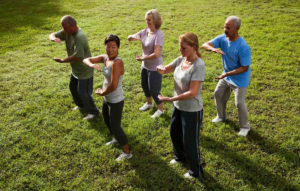Walking is a fundamental activity we often take for granted, but it’s not as simple as it seems. Our ability to walk relies on a complex interplay of muscles, balance, and coordination. Incorporating yoga into your routine can significantly enhance your walking experience, helping you relearn to walk with greater ease and efficiency. In this article, we’ll explore how yoga can help build coordination and strength through slow, deliberate movements.
The Connection Between Yoga and Walking
Yoga and walking might seem like distinct activities, but they share a common goal: enhancing body awareness and movement efficiency. By integrating yoga into your daily routine, you can address muscle imbalances, improve flexibility, and develop a stronger sense of balance, all of which are crucial for effective walking.

Enhancing Body Awareness
One of the key benefits of yoga is its ability to enhance body awareness. Yoga encourages you to focus on your body’s alignment and movements, helping you become more attuned to how you walk. Through mindful practice, you can identify areas of tension or weakness that may be affecting your gait.
Improving Flexibility and Strength
Yoga is well-known for its ability to increase flexibility and strength. Poses that target the lower body, such as Warrior II and Chair Pose, can help strengthen the muscles used in walking, including the calves, quadriceps, and hamstrings. Improved flexibility in the hips and ankles also contributes to a more fluid and efficient walking motion.
Key Yoga Poses for Walking
To effectively enhance your walking ability through yoga, focus on poses that build strength and flexibility in the lower body while also improving balance. Here are a few key poses to incorporate into your practice:
1. Warrior II (Virabhadrasana II)
Warrior II is excellent for building strength in the legs and improving overall stability. Begin by standing with your feet wide apart and turn one foot out to 90 degrees while keeping the other foot parallel. Bend the front knee and extend your arms out to the sides, gazing over your front hand. Hold this position for several breaths, then switch sides.
2. Chair Pose (Utkatasana)
Chair Pose helps strengthen the quadriceps and improves balance. Start by standing with your feet together and bend your knees as if sitting back into an invisible chair. Extend your arms overhead and engage your core muscles. Hold the pose for several breaths, focusing on maintaining a steady, balanced position.
3. Tree Pose (Vrksasana)
Tree Pose enhances balance and stability, which are crucial for walking. Stand on one leg and place the sole of your other foot on the inner thigh or calf (avoid the knee). Bring your hands together at your chest or extend them overhead. Focus on a fixed point in front of you to help maintain balance. Switch legs after holding for several breaths.
Relearn to Walk with Yoga
As you practice these yoga poses, you’ll begin to notice improvements in your walking technique. Yoga encourages a mindful approach to movement, which helps you relearn to walk with greater awareness and efficiency. Pay attention to your gait and how your body feels as you walk. You may find that areas of discomfort or imbalance become less pronounced as you strengthen and align your body through yoga.
Integrating Yoga into Your Walking Routine
To maximize the benefits of yoga for walking, try incorporating yoga sessions into your weekly routine. Start with two to three sessions per week, focusing on poses that target the lower body and improve balance. Complement your yoga practice with regular walking sessions to reinforce the connection between the two activities.
Practicing Mindfulness
In addition to physical benefits, yoga promotes mindfulness, which can enhance your walking experience. Practice walking with a sense of awareness, paying attention to each step and how your body moves. This mindful approach can lead to a more enjoyable and effective walking experience.
Conclusion
Yoga offers a valuable tool for enhancing your walking ability by building coordination, strength, and body awareness. By incorporating key poses into your routine and practicing mindfulness, you can relearn to walk with greater ease and efficiency. Embrace the slow, deliberate movements of yoga to transform your walking experience and improve your overall well-being.
Leave a Reply